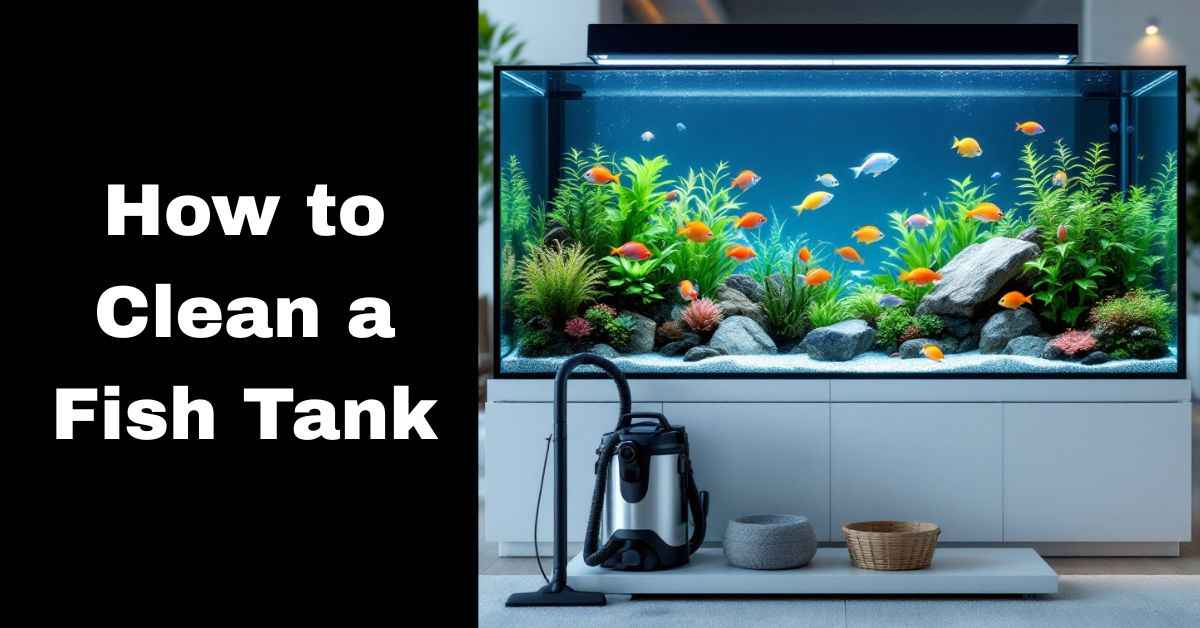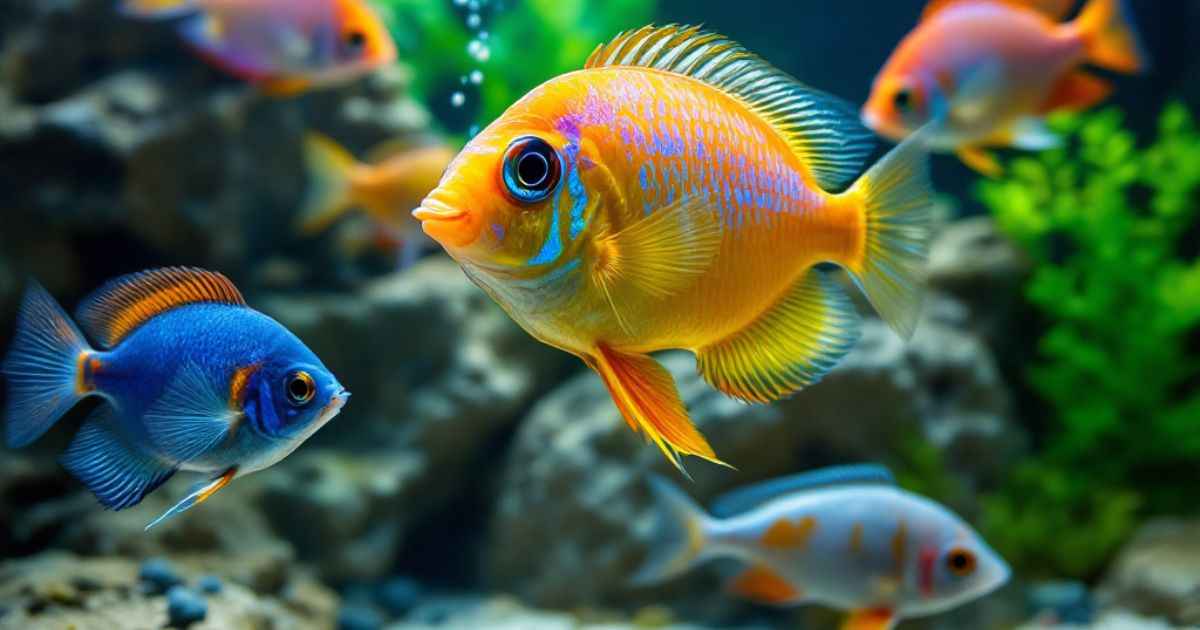Keeping your fish tank clean isn’t just about appearances—it’s about creating a healthy, thriving environment for your aquatic friends. A dirty tank can lead to poor water quality, stress, and even illness for your fish. But don’t worry! Cleaning a fish tank doesn’t have to be a daunting task. With the right tools, techniques, and a little know-how, you can maintain a crystal-clear aquarium that both you and your fish will love.
In this article, we’ll dive into everything you need to know about how to clean a fish tank. From understanding why cleaning is essential to learning the step-by-step process, we’ve got you covered. We’ll also share tips for avoiding common mistakes and maintaining a clean tank long-term. Let’s get started!
Why Cleaning Your Fish Tank is Important
Cleaning your fish tank regularly is more than just a chore—it’s a vital part of aquarium care. A clean tank ensures your fish stay healthy, your water quality remains stable, and your aquarium looks stunning.
Let’s explore why this is so important.
1. Preventing Diseases in Fish
Fish are highly sensitive to their environment. Poor water quality caused by waste buildup, uneaten food, or algae can lead to harmful toxins like ammonia and nitrates. These toxins can stress your fish, weaken their immune systems, and make them more susceptible to diseases. Regular cleaning helps keep these toxins in check, ensuring your fish stay happy and healthy.
2. Maintaining Water Quality
A clean tank means balanced water chemistry. By removing debris and performing water changes, you can maintain stable pH levels and reduce harmful substances. This creates a safe and comfortable environment for your fish to thrive.
3. Enhancing the Beauty of Your Tank
Let’s face it—a sparkling clean aquarium is a joy to look at. Clearwater, vibrant fish, and algae-free glass make your tank the centerpiece of any room. Regular cleaning ensures your tank always looks its best.
4. Improving Visibility for Observation
A clean tank allows you to fully enjoy watching your fish swim, interact, and explore their environment. Cloudy water or algae-covered glass can obscure your view, taking away from the joy of owning an aquarium.
5. Extending the Life of Your Aquarium Equipment
Did you know that neglecting your tank can damage your equipment? Filters, heaters, and pumps can become clogged with debris, reducing their efficiency and lifespan. Regular cleaning prevents this, saving you money in the long run.
6. Reducing Stress for Fish
Fish are creatures of habit, and sudden changes in their environment can stress them out. By maintaining a clean and stable tank, you minimize disruptions and keep your fish calm and content.
How Often Should You Clean a Fish Tank?
When it comes to how to clean a fish tank, knowing how often to do it is just as important as understanding the cleaning process itself.
Over-cleaning can disrupt the delicate balance of beneficial bacteria in your tank while under-cleaning can harm water quality and your fish’s health.
The right frequency depends on several factors, which we’ll break down below.
Factors That Determine Cleaning Frequency
1. Tank Size and Type
The size of your tank plays a big role in how often it needs cleaning. Smaller tanks get dirty faster because they have less water to dilute waste, meaning they require more frequent maintenance. On the other hand, larger tanks, especially those with advanced filtration systems, can go a bit longer between cleanings.
Additionally, the type of tank matters—freshwater tanks usually require less frequent cleaning than saltwater aquariums due to the latter’s more complex ecosystems.
2. Number and Type of Fish
The more fish you have in your tank, the quicker waste builds up. Some species, like goldfish, are notoriously messy and produce more waste than others.
If your tank is heavily stocked or contains messy eaters, you’ll need to clean it more often to keep water quality in check.
Signs Your Tank Needs Cleaning
1. Cloudy or Discolored Water
One of the most obvious signs that your tank needs cleaning is cloudy or murky water. This could be caused by uneaten food, excess fish waste, or an algae bloom—all of which indicate it’s time for a water change or deep cleaning.
2. Algae Growth on Glass or Decorations
If you notice algae forming on your tank’s glass, plants, or decorations, it’s a clear sign that your aquarium needs attention. While some algae are normal, excessive growth can reduce oxygen levels and make your tank look unsightly.
Weekly vs. Monthly Maintenance Tasks

Routine Water Changes
Weekly water changes are essential for maintaining water quality. Replacing 10–20% of the tank’s water helps remove harmful toxins like ammonia and nitrates while preserving beneficial bacteria. This is especially important in smaller tanks or those with a lot of fish.
Deep Cleaning Schedule
Deep cleaning, which involves scrubbing the glass, cleaning the substrate, and rinsing the filter, should typically be done every 3–4 weeks. However, the exact timing may vary based on the size of your tank, the type of fish you have, and how quickly debris builds up.
Essential Tools and Supplies for Cleaning a Fish Tank
To properly tackle how to clean a fish tank, you’ll need the right tools and supplies.
Using the correct equipment not only makes the job easier but also ensures you don’t accidentally harm your fish or disrupt the tank’s ecosystem.
Below is a rundown of must-have cleaning tools and helpful supplies for aquarium maintenance.
1. Gravel Vacuum
A gravel vacuum is a game-changer when it comes to cleaning your tank’s substrate. It allows you to remove debris, leftover food, and waste from the gravel without having to take it out of the tank. Plus, it doubles as a tool for partial water changes, making it an essential part of your cleaning arsenal.
2. Algae Scraper or Magnet Cleaner
Algae buildup is inevitable in any fish tank, but with an algae scraper or magnet cleaner, you can easily keep your glass spotless.
Magnet cleaners are particularly handy because they allow you to clean the inside of the tank without getting your hands wet.
3. Water Testing Kits and Conditioners
Monitoring your tank’s water chemistry is crucial for maintaining a healthy environment. Water testing kits let you quickly check levels of pH, ammonia, nitrites, and nitrates, ensuring everything stays within the safe range for your fish.
4. Dechlorinators and Water Conditioners
Tap water contains chlorine and other chemicals that can harm your fish. Dechlorinators and water conditioners neutralize these chemicals, making your water safe for aquarium use. Always treat replacement water before adding it to your tank.
5. Buckets and Towels
A dedicated bucket for aquarium use is a must-have for water changes. Avoid using buckets that have been exposed to cleaning chemicals, as even trace amounts can be toxic to fish.
Towels are also helpful for drying surfaces and catching spills during the cleaning process.
6. Replacement Filters
Filters play a vital role in keeping your tank clean by removing debris and toxins. Having replacement filter cartridges or media on hand ensures you can swap them out as needed, keeping your system running smoothly.
Step-by-Step Guide: How to Clean a Fish Tank
Cleaning your fish tank might seem like a big task, but breaking it down into simple steps makes it manageable and even enjoyable.
This step-by-step guide will walk you through how to clean a fish tank effectively while keeping your fish safe and your tank’s ecosystem intact.
1. Preparing for the Cleaning Process
Turning Off Equipment
Before you start cleaning, turn off all electrical equipment, such as filters, heaters, and lights. This ensures your safety and prevents damage to the equipment during the cleaning process. Plus, it makes it easier to access all parts of the tank.
Removing Fish Safely (If Necessary)
In most cases, you don’t need to remove your fish while cleaning. However, if you’re doing a deep clean or working in a small tank, temporarily transferring your fish to a separate container with tank water can reduce stress. Use a soft net to avoid harming them.
2. Cleaning the Tank Interior

Removing Algae from Glass
Algae buildup on the glass can make your tank look dirty and block your view of your fish. Use an algae scraper or magnet cleaner to gently remove algae from the inside of the tank. Be careful not to scratch the glass, especially if you have an acrylic tank.
Cleaning Decorations and Plants
Take out any decorations, artificial plants, or rocks that have visible algae or debris. Rinse them under warm water and scrub gently with a soft brush.
Avoid using soap or chemicals, as even small traces can harm your fish.
3. Cleaning the Substrate

Using a Gravel Vacuum
The substrate (gravel or sand) collects uneaten food, fish waste, and other debris. A gravel vacuum is the best tool for cleaning it. Simply siphon the debris while leaving the substrate in place. This helps maintain the beneficial bacteria that live in the gravel.
Avoiding Over-Cleaning to Preserve Beneficial Bacteria
While cleaning the substrate, avoid removing too much debris at once. Beneficial bacteria play a crucial role in breaking down waste and maintaining water quality. Over-cleaning can disrupt this balance, leading to water chemistry issues.
4. Water Changes
How Much Water to Replace
Partial water changes are key to maintaining a healthy tank. Replace 10–20% of the water weekly or 25–30% every two weeks, depending on your tank’s size and stocking levels. This helps remove toxins like ammonia and nitrates without shocking your fish.
Preparing Replacement Water
Always treat tap water with a dechlorinator or water conditioner before adding it to your tank. Match the temperature of the replacement water to the tank water to avoid stressing your fish.
5. Cleaning the Filter
When and How to Clean the Filter
Your filter is the heart of your tank’s ecosystem, so it’s important to clean it properly. Rinse the filter media in a bucket of tank water (not tap water) to preserve beneficial bacteria. Clean the filter housing and replace media only when necessary.
Avoiding Damage to Beneficial Bacteria
Never clean all parts of the filter at once. Stagger cleanings to ensure some beneficial bacteria remain intact, which helps maintain water quality.
6. Reassembling and Restarting the Tank
Refilling the Tank
Once you’ve finished cleaning, slowly refill the tank with the treated replacement water. Pour the water gently to avoid disturbing the substrate or stressing your fish.
Turning Equipment Back On
After refilling the tank, turn your equipment back on, including the filter, heater, and lights. Check that everything is working properly and that the water temperature is stable before leaving your fish to settle back in.
Common Mistakes to Avoid When Cleaning a Fish Tank
Even with the best intentions, it’s easy to make mistakes when learning how to clean a fish tank. Avoiding these common pitfalls will help you maintain a healthy, balanced aquarium and keep your fish happy.
1. Over-Cleaning the Tank
One of the biggest mistakes aquarium owners make is over-cleaning. Scrubbing every surface, replacing all the water, or cleaning the filter too thoroughly can remove the beneficial bacteria your tank needs to stay healthy.
These bacteria help break down waste and keep toxins like ammonia and nitrites in check.
Without them, your tank’s water chemistry can quickly become unstable.
2. Using Harsh Chemicals
Never use soap, bleach, or other harsh chemicals to clean your tank or its decorations. Even trace amounts can be toxic to fish.
Instead, stick to warm water and aquarium-safe cleaning tools. If you need to disinfect something, use a diluted vinegar solution and rinse thoroughly.
3. Neglecting Regular Maintenance
Skipping regular maintenance can lead to a host of problems, from algae overgrowth to poor water quality.
Over time, waste and debris build-up, creating an unhealthy environment for your fish.
By sticking to a cleaning schedule, you can prevent these issues and keep your tank looking its best.
Related Articles:
- Oscar Fish Guide: Care, Habitat, Diet, and Tank Setup
- Electric Blue Ram Care: Tank, Diet, and Breeding Tips
- Koi Betta Fish: Care, Lifespan, Tank Mates, Size, Food, & More
FAQs
Can I Use Tap Water to Clean My Tank?
Yes, but tap water must be treated with a de-chlorinator or water conditioner before use. Chlorine and other chemicals in untreated tap water can harm your fish and disrupt the tank’s ecosystem. Always prepare replacement water in advance to ensure it’s safe.
Do I Need to Remove My Fish When Cleaning the Tank?
In most cases, you don’t need to remove your fish during routine cleaning. However, if you’re doing a deep clean or working in a small tank, temporarily moving your fish to a container with tank water can reduce stress. Be gentle when transferring them to avoid injury.
How Do I Clean a Tank with Live Plants?
Cleaning a tank with live plants requires extra care. Avoid scrubbing or removing plants unless necessary. Instead, gently vacuum around the plants to remove debris and trim any dead or decaying leaves. Live plants can help maintain water quality by absorbing nitrates, so keeping them healthy is beneficial for your tank.
Conclusion
Maintaining a clean fish tank is more than just a routine task—it’s a commitment to the well-being of your aquatic pets and the beauty of your aquarium. By following the steps outlined in this guide on how to clean a fish tank, you can create a safe, healthy, and visually stunning environment for your fish to thrive.




